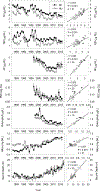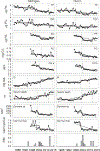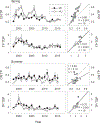A Comparative Examination of Recent Changes in Nutrients and Lower Food Web Structure in Lake Michigan and Lake Huron
- PMID: 31156289
- PMCID: PMC6541410
- DOI: 10.1016/j.jglr.2018.05.012
A Comparative Examination of Recent Changes in Nutrients and Lower Food Web Structure in Lake Michigan and Lake Huron
Abstract
The lower food webs of Lake Huron and Lake Michigan have experienced similar reductions in the spring phytoplankton bloom and summer populations of Diporeia and cladocerans since the early 2000s. At the same time phosphorus concentrations have decreased and water clarity and silica concentrations have increased. Key periods of change, identified by using a method based on sequential t-tests, were 2003-2005 (Huron) and 2004-2006 (Michigan). Estimated filtration capacity suggests that dreissenid grazing would have been insufficient to directly impact phytoplankton in the deeper waters of either lake by this time (mid 2000s). Despite some evidence of decreased chlorophyll:TP ratios, consistent with grazing limitation of phytoplankton, the main impact of dreissenids on the offshore waters was probably remote, e.g., through interception of nutrients by nearshore populations. A mass balance model indicates that decreased phosphorus loading could not account for observed in-lake phosphorus declines. However, model-inferred internal phosphorus dynamics were strongly correlated between the lakes, with periods of increased internal loading in the 1990s, and increased phosphorus loss starting in 2000 in Lake Michigan and 2003 in Lake Huron, prior to dreissenid expansion into deep water of both lakes. This suggests a limited role for deep populations of dreissenids in the initial phosphorus declines in the lakes, and also suggests a role for meteorological influence on phosphorus dynamics. The high synchrony in lower trophic level changes between Lake Michigan and Lake Huron suggests that both lakes should be considered when investigating underlying causal factors of these changes.
Keywords: Diporeia; Lake Huron; Lake Michigan; chlorophyll; phosphorus; zooplankton.
Figures











References
-
- Ackerman JD, Loewen MR, Hamblin PF, 2001. Benthic–pelagic coupling over a zebra mussel reef in western Lake Erie. Limnol. Oceanogr 46, 892–904.
-
- APHA (American Public Health Association), 1985. Standard Methods for the Examination of Water and Wastewater. 16th ed. Washington, D.C.: American Public Health Association.
-
- Barbiero RP, Rockwell DC, Warren GJ, Tuchman ML, 2006. Changes in spring phytoplankton communities and nutrient dynamics in the eastern basin of Lake Erie since the invasion of Dreissena spp. Can. J Fish. Aquat. Sci 63: 1549–1563.
-
- Barbiero RP, Balcer M, Rockwell DC, Tuchman ML, 2009a. Recent shifts in the crustacean zooplankton community of Lake Huron. Can. J. Fish. Aquat. Sci 66, 816–828.
-
- Barbiero RP, Bunnell DB, Rockwell DC, Tuchman ML, 2009b. Recent increases in the large glacial-relict calanoid Limnocalanus macrurus in Lake Michigan. J. Great Lakes Res 35, 285–292.
Grants and funding
LinkOut - more resources
Full Text Sources
